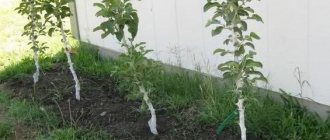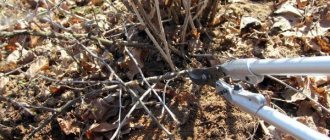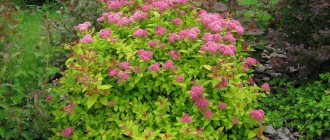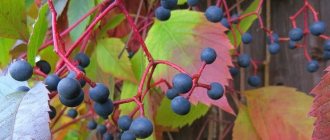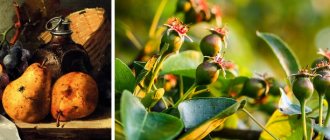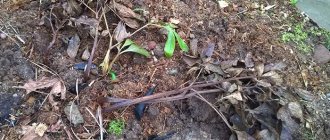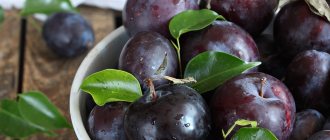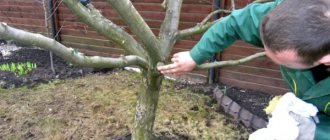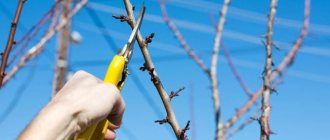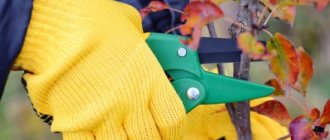The best time to prune a pear tree
Gardeners with extensive experience in growing fruit trees advise pruning in early spring. In this case, the pear is allowed to be pruned twice a year - in early spring and autumn.
In the spring, they not only form the crown, but also remove branches damaged by the cold. In the pre-winter period, it is also allowed to thin out and rejuvenate the pear. But it is recommended to do this only with winter-hardy varieties, since pruning significantly weakens the tree and reduces its frost resistance.
Also in the autumn, the protective powers of the pear decrease, but fungal spores begin to actively spread. Therefore, pruning pear trees is risky. But the coin always has two sides.
Advantages of autumn pruning:
- more predictable weather conditions (in spring it’s easy to be late or, conversely, trim a tree too early);
- after severe pruning in the spring (if this was required), the pear yield decreases, but not in the autumn;
- the tree recovers more easily, since the plant does not need to double its strength to heal wounds and form fruits.
Step-by-step instruction
Professional gardeners with many years of experience have developed a detailed guide for beginners. Thanks to this, each garden owner will be able to prune the branches independently .
- Removing diseased branches and dried shoots. This stage is considered basic, since any manipulations with the tree are impossible until all problem areas are removed. Only through this can the risk of accidental breakage of healthy branches be completely eliminated. If the shoot has been affected by pests, then pruning must begin from the most problematic area. Dry wood is quite easy to distinguish from living wood: during spring and summer, leaves and fruits do not appear on it.
- Removal of all root growth. Both spring and autumn are perfect for this procedure. There is no need to worry, since these shoots have nothing to do with the fruit crown, but are a continuation of the root system. If they have not yet become woody, then they can simply be broken at the base. Otherwise, you can use a sharp pruner or shovel. If the shoots have become very massive, then it is best to get rid of them in late autumn, when it is cold outside, since at this time various insects and larvae settle on the plant for further wintering.
- Trimming thick tops, which almost always grow in a vertical direction. They can be observed at a distance of 2 meters from the trunk, at the base of large branches. They don’t produce fruit, but they take a lot of strength from the tree. They need to be cut as close to the growing point as possible.
- Trimming annual growth to buds. This procedure is extremely important for a good harvest. The shoots must be cut to a quarter of their original length. Several healthy buds are left on annual shoots so that they can develop next spring.
Deadlines
In order for the removal of branches to benefit the tree, it is necessary to calculate the favorable period for carrying out this procedure. If you are late or rush with pruning, you can cause serious damage to the tree, provoke its illness and even death.
When is it recommended to prune a pear:
- In the spring. Pruning is carried out before sap flows through the branches of the tree. It is advisable that there be only a few days between the procedure and sap flow. When it starts, the tree’s immunity will immediately turn on, preventing the development of pathogenic organisms.
- In autumn. The main signal to start the procedure is the falling of leaves. Another condition is positive air temperature. If the thermometer drops below minus 5 °C, pruning is no longer carried out.
There are no exact calendar dates for pruning. In addition, they depend on the region and current weather conditions. So in a temperate climate, autumn pruning is completed before the second ten days of October, in the spring work begins at the end of March.
When to prune
Pruning pears in the fall begins immediately after harvest. By this time, the tree begins to enter a dormant period, sap flow slows down and the crop tolerates this procedure less painfully. The timing of pruning in each region is different and is primarily based on the climatic characteristics of the region. The weather during pruning should be dry, and the average daily air temperature should not drop below 8 degrees Celsius. If very early frosts came to the region where the tree grows, then it is better to postpone the pruning procedure until spring.
In the Moscow region, Central zone
In the Moscow region and in central Russia, pear pruning is carried out after harvesting from the end of August to the second ten days of October.
Early varieties are pruned in late August - mid-September.
Mid-season and late varieties are pruned before October 10.
If the weather this year allows, then pruning can be extended until October 15, the main thing is that there are at least 2 weeks left before the first frost.
In the Urals, in Siberia
The optimal time for pruning in the Urals is considered to be the period from September 5 to September 30. In Siberia, pruning begins in August and ends by the middle of the first autumn month. At the same time, varieties with low winter hardiness, as well as late varieties, are pruned not in the fall, but in the spring.
Leningrad region
In the Leningrad region, the timing of the pruning procedure is planned for the period from September 10 to October 6. When pruning, the varietal characteristics of the tree are also taken into account.
What kind of pruning is there?
Pear pruning is carried out taking into account the age of the tree, as well as the goals set. Depending on this, there are several types of pruning:
- Sanitary. Pruning dried, damaged, with signs of disease and frozen branches. The recommended execution time is any.
- Thinning. Since the pear is characterized by intensive shoot formation, excess shoots are removed so that there is normal air circulation in the crown. Branches growing inside the crown, tops, and intersecting shoots are trimmed.
- Formative. The crown is formed in the first years of the tree's life. This has a positive effect on its longevity and fruiting.
- Stimulating. Its essence is to shorten the shoots. The goal is to limit the growth of branches. The result is stimulation of the growth of side shoots.
- Rejuvenating. Prolongs the fruiting of the tree and increases productivity.
General rules for pruning pears by season
Depending on what time the pruning is carried out, certain rules are followed. In addition, a certain type of pruning is recommended for each season.
Spring
Before the buds swell and sap flow begins, start pruning. Regardless of what type of pruning is performed and how old the tree is, certain rules must be followed. This will allow you not to harm the pear tree and get a positive effect from the procedure.
Cut thin branches with a sharp pruner, and thick branches with a hacksaw. All blades should be disinfected. For disinfection, use alcohol-containing compounds.
When pruning, follow these rules:
- Start by thinning the crown so that light and air reach all fruiting branches.
- After thinning, if necessary, shorten the central trunk by 1/4 to form a cup-shaped crown.
- Disinfect the sections.
- Remove shoots that grow vertically, as well as branches pointing downward - they are unproductive.
See also video material on pruning pears in spring:
Autumn
Autumn pruning is recommended for early and mid-ripening pears.
Autumn pruning rules:
- Prune the pear tree moderately in the fall, otherwise the tree will spend too much energy on restoration, and before wintering this is completely useless. In addition, the tree will send out many vertical shoots.
- It is recommended to remove branches in stages - a little every year.
- Start pruning with shoots that have grown in relation to the trunk at an angle of 90 degrees. Then move on to those that grow vertically.
- After work, disinfect the sections.
When cutting branches, focus on the ring-like ridges on the bark - they are located between the trunk and the base of the branches. Cut directly along the influx, then the wound will heal quickly, since it contains tissues that speed up recovery.
In addition to the above, watch the following video:
Summer
In summer, the pear is only pinched. This procedure is also called pinching. You can remove the tops of the shoots with your fingers or a cutting tool.
Pinching takes much more time than pruning, but you shouldn’t give it up. After pinching, the tree actively accumulates strength, as it uses nutrients more economically and evenly.
In summer, you can prune a pear tree if it has grown a lot of young shoots that thicken the crown. The tree's reaction may depend on the timing of pruning:
- June. Delays shoot growth. Because of this, the axillary buds produce summer shoots ahead of time. Leaf buds transform into fruit buds. Pinching in June has a bad effect on the growing season of the tree and complicates its wintering.
- July August. At this time, the shoots finish their growth. Pinching enhances the development of axillary buds.
How to prune a pear in the summer is described in the video below:
Useful tips from experts
Pruning patterns for young and old trees are significantly different. During planting, seedlings are always subject to a certain stress; the root system may be damaged, which is why the tree will not grow well. A young pear spends a lot of effort on forming the crown and restoring the root system. If you trim the branches immediately after planting, this will help the seedling to take root faster and grow roots. Due to this, the tree will receive much more useful substances, which are extremely important for the normal growth of fruiting branches and fruit growth.
To ensure that the crown shape is initially correct, you need to shorten the main trunk annually, which will save time on scheduled pruning. The gardener will only have to remove damaged and dried shoots. If the tree is already several years old, then pruning is done twice a year. The pyramidal crown shape is most suitable for the home garden.
It is best to form a pear in early spring or early autumn. When the tree reaches four years of age, the gardener can safely begin to form the second tier of skeletal branches. With each subsequent year, there will be fewer and fewer young shoots, which is why pruning must be selective. You need to be especially careful with fruiting branches, as they cannot be touched.
A perennial tree cannot produce a good harvest without quality rejuvenation. The procedure is based on cutting down an old branch that has already stopped bearing fruit. As a result, the crown is thinned out, ventilation is improved, and the growth of new branches is stimulated. It is advisable to carry out the rejuvenating procedure in winter, as well as in early spring. It is very important to do it before the active movement of juice begins. The ambient temperature must be within 0 °C.
Pruning based on age and other factors
The pear is pruned annually, in accordance with age and other characteristics. There is no single pruning scheme for all occasions - you need an individual approach to each tree.
After landing
The pear is characterized by large annual growth and small formation of skeletal branches. Mostly small ringed branches and short spears are formed. Another feature of the pear is the accelerated growth of the central conductor. It must be transferred to the lower buds, otherwise the pear will grow too tall.
As a rule, nurseries sell two-year-old seedlings consisting of a guide and 5-6 lateral branches. Therefore, from the first year of a young tree’s life, begin formative pruning of its crown:
- Shorten the trunk by 50-60 cm from the soil level to stimulate the growth of lateral branches.
- Shorten the side branches above the buds by 10-15 cm.
- Pinch off the buds located near the ground so that the seedling does not waste energy on the growth of lower shoots. In addition, these shoots will still have to be removed later.
Pruning the seedling makes it easier for the tree to take root. Its roots are still very weak, and if the buds begin to actively develop, they will not be able to provide the young pear with the necessary nutrition.
If the seedling is planted and pruned in the spring, it does not require pruning in the fall.
Two year old pear
In the 2nd year they continue to form the crown. A two-year-old tree has side branches; you need to select three shoots and trim the rest.
Rules for pruning a two-year-old tree:
- Achieve an even distribution of branches around the trunk.
- The optimal angle between the trunk and branches is 120 degrees.
- Vertical spaces between branches are from 10 to 22 cm.
- Having selected the necessary branches, trim all the rest:
- cut branches lower than the lowest selected branch;
- cut the branches that will be skeletal on the 1st tier into thirds;
- Shorten the central trunk so that 80-90 cm remains from the ground to the farthest branch of the 1st tier.
Three-year-old
A three-year-old pear is pruned in almost the same way as a two-year-old tree. Continue to form the crown.
Pruning a three-year-old pear:
- Your task is to organize the 2nd tier. There should be about 70 cm between the first and second tier.
- For the 2nd tier, select 3 branches growing at a large angle from the trunk. Shorten them by a third. Cut the branches of the 1st tier by the same amount.
- Trim the main conductor, retreating 40-50 cm from the location of the farthest branch in the second tier.
- Cut out all other branches growing from the trunk. On them, remove unnecessary, competing shoots so that only one remains - the leader.
Four year old pear
In the fourth year of the tree’s life, a similar laying of the third tier is made. Only now the distance between the 2nd and 3rd tier is about 40-50 cm.
Two branches directed in different directions will be enough; all unnecessary ones are cut out. The trunk is shortened in order to transfer growth to the side branch.
Five-year-old
By the fifth year, gardeners finish forming the crown. If pruning has been carried out without errors for 4 years, the pear should have a height of about 4 m and three tiers.
Mature pear
It is advisable to prune a tree whose age has exceeded 5-6 years in the spring. And you need to start with sanitary pruning. The further procedure for pruning an adult pear is as follows:
- Clean the barrel. After sanitary pruning, proceed to cleaning the trunk. It consists of removing numerous shoots growing from the central trunk.
- Remove competitors. Often, pear trees grow competing shoots parallel to the trunk. Trim them. A tree should have only one leading trunk.
- Limit upward growth. The peculiarity of pear trees is the desire to grow upward throughout the entire period of life. The branches on the upper tier that stretch upward must be trimmed.
- Lighten the crown. Remove all branches growing vertically up, down, or crossing. Another task when lightening is trimming the tops. Shorten the annual growth by three buds.
Old
Old pears will benefit from rejuvenation. It is not carried out in a year or two - it takes several years to rejuvenate it correctly, without compromising the health of the tree. When an old skeletal branch is removed, a new one is grown to replace it.
The maximum proportion of branches removed at a time is 1/3 of the total mass.
Trees in disrepair may also need rejuvenation. With an abundance of green mass, they produce little fruit. Bringing old trees back to life is difficult, but possible. To prevent the tree from suffering due to stress caused by severe pruning, it is carried out 3 times at intervals of 1-2 years.
How to rejuvenate an old pear:
- Form two tiers on the tree. Leave a distance of 1 m between them. Where the topmost branch leaves, cut down the trunk.
- Leave 5 to 7 strong branches on one tier. Cut the rest at the trunk.
- Clear each skeletal branch of excess shoots, cut out the tops and intersecting branches. Cut off all the growth from the trunk.
To rejuvenate an old tree, gardeners often simply cut it down in half or at a height of 1.5 m from the ground. Next year, a new tree with a regular or cup-shaped crown begins to form from the grown shoots.
Columnar pear
Pruning of columnar pears is carried out mainly for decorative purposes. Only the side branches are shortened so that the tree maintains its compactness. The trunk is not touched.
To maintain columnar pears in normal condition, annual sanitary pruning is sufficient, during which broken and dried branches in the internal space of the crown are removed.
Karlikova
Such pears are especially often grown in areas with harsh climates. They are closed for the winter to protect them from frost.
How to form a dwarf pear:
- Immediately after planting, trim the tree at a height of 40-50 cm from the soil.
- In the 2nd year, cut off the side branches (usually 4-5 of them) by a third.
- Trim the trunk to 15-20 cm.
In subsequent years, shorten the growth by a third. The height of a dwarf pear should be 1.5-2 m.
Big pear
A tree that is too tall and spreading can create big problems on the site. If it is higher than 3 m, then caring for it is complicated.
The height of the overgrown pear must be reduced by 1.5-2 m. Then all dry and old branches are removed. Further actions depend on how old the tree is and what condition it is in.
Tip 2: Tops
The strong shoots of the current year are called tops. They thicken the crown and do not let in the rays of light that are necessary for the sweetness and normal ripeness of the fruit. Moreover, these shoots take a lot of energy from the plant, so next year the yield may decrease noticeably. Inflorescences do not develop on the tops themselves for several years.
It is not difficult to distinguish a top: it always grows vertically, it has greenish young bark and a fairly large diameter. Such shoots must be pruned. An exception is made only for one or two, which will later become part of the crown skeleton (if necessary). In adult pears, every single one is cut off, unless left in place of a sawed off or broken old branch.
Related article:
What to do with tomato leaves - cut or leave on the bush?
Crown formation
It is carried out over several seasons. The pruning scheme depends on what crown shape is chosen.
People with extensive experience in gardening claim that the most practical crown shapes for pear trees are cup-shaped and spindle-shaped.
Sparsely tiered form
This is the simplest option. The tree takes on the most natural shape possible. The branches are arranged in tiers consisting of 2-3 branches.
How to form a sparsely tiered crown:
- Select a section of the trunk that will be the trunk - approximately 50 cm.
- Measure 40 cm from the trunk - there will be skeletal branches of the 1st tier. And the central conductor is cut off. They cut it off above a strong bud - it will give rise to a shoot from which a continuation of the trunk will grow.
- The main branch should be 20 cm higher than the side branches.
- After a year, clear the stem of growth. And begin to form tiers according to the scheme described above.
- Form one tier each year. Leave 3 branches on the first one, trim the rest to slow down their growth and increase yield.
Improved longline
This is an improved version of the previous crown formation scheme, in which additional skeletal branches are left. So, in the first tier, instead of 3 branches, 4 are left, and for laying the 2nd tier, about 6 buds are left.
Recommended scheme:
- on the first tier - 4 branches;
- on the next one - 2-3 branches;
- the third tier is missing, instead there are 2 separate branches.
Spindle-shaped crown
Professional gardeners love this scheme. Pears with a spindle-shaped crown bear fruit earlier, have high yields, and are characterized by good ventilation and illumination of the fruit branches.
The main feature of the scheme is the many semi-skeletal branches. They are tied up so that they are in a horizontal position. Then the branches are arranged in a spiral, at intervals of 2-3 buds.
The disadvantage of the scheme is that the lower branches sag, which makes it difficult to care for the trunk circle and trunk.
Cup-shaped
The second name for the crown is vase-shaped. The scheme provides for pruning without selecting the leading branches (the skeletal branches are lined up in one tier). The conductor is cut off in the first year of planting, and 3-4 branches are left to form the frame.
Semi-flat shape
This option is good for mini-plots. A special feature is the presence of 4-6 branches placed at an angle of 50° relative to the trunk. In the bottom row there are two branches growing in a mirror position.
In the second and subsequent tiers only 2 branches are left. If the tree is vigorous, the ideal distance between tiers is 1 m; if it is medium-sized, it is 0.8 m.
Tip 4: maximalism
When pruning in the fall, you need to take into account that the transparency of the crown is important for the health of the pear. The fewer branches are located closely to each other, the better air circulates between the foliage and ovaries. This prevents the development and spread of fungal diseases even during rainy periods. In addition, with such a crown, it is easier to treat the pear with various preparations: fertilizers, insecticides, antifungal agents, etc.
Related article:
Schemes for proper plum pruning
In addition, significant pruning allows you to improve the taste of the fruit, make them sweeter, accumulate vitamins in the pulp and shorten the ripening period.
General questions about pear pruning
Pruning is considered the most difficult and responsible activity when growing fruit trees. Beginners often reach a dead end when they decide to prune trees themselves. Let's consider points that may raise questions for inexperienced gardeners:
- Is it possible to trim the top of a pear? The central conductor is pruned only from a young seedling and only once a year, otherwise the tree will be too tall.
- Do the tops need to be trimmed? These are competitors of the leaders, subject to ruthless cutting. They do not bear fruit and only thicken the space. But there are cases when tops are used to form a full-fledged fruit-bearing shoot. To do this, the shoots are transferred to a horizontal position, cutting them to the outer bud or bending them with a rope.
- Pruning for replacement branches: why is it done and how? This method of pruning allows you to form a fruiting unit, which consists of one or more fruiting branches, and a replacement knot. This is usually done no earlier than the 4th year of life. The essence of the process: pruning shoots with flower buds for fruiting. Remove 1/3 or 1/4 of the length. All others are left to grow, keeping 2-3 buds.
- How to prune a frozen pear? Pruning is carried out taking into account the damage received. If the crown of an annual tree planted as a canopy is damaged, it must be shortened by a third of its length. But this procedure is recommended for all young trees that have survived the winter. In mature trees, after wintering, branches are removed (completely or down to healthy wood) depending on the degree of damage. The affected areas are easily identified by their dark color (in places where the bark freezes, it becomes black or dark brown).
- How to cut down a thick branch? Removal is carried out in stages. This approach is convenient for the gardener and does not injure the pear. When doing such pruning, it is important not to harm the tree; external attractiveness must be neglected. It is necessary to wait until the dormant buds wake up for new shoots to appear. When the “stump” is a little overgrown with branches, it will be possible to begin forming the crown.
How to properly prune a pear in the fall: advice from professionals
When pruning pears in the fall, it is important not only to choose the right time, but also to prepare thoroughly.
Required tools and materials
To prune pears in the fall you will need:
- knife for removing young and thin branches;
- pruning shears or loppers for trimming shoots of medium thickness;
- saw;
- garden pitch or other available means for processing cuts;
- ladder.
All tools must be sharp to make smooth, least traumatic cuts, and treated with disinfectants. If several trees are to be processed, then the tools are cleaned and disinfected after each of them.
What, with what and how
Secateurs are most convenient for working with accessible, often single shoots of small thickness. It is convenient for them to cut branches into buds. The lopper is great for shortening a large number of shoots located at height. It is worth noting that it is difficult to achieve the great precision that is necessary when forming the crown.
The saw is used to remove strong branches and remove shoots of medium thickness under the ring.
There are two basic techniques for pruning pears not only in autumn, but also at any other time of the year:
- Under the kidney. The cut is made at a height of 1-2 mm above the selected, preferably strong, bud. It is performed at a slight angle in the direction of the kidney.
- Under the ring. The cut is made along the influx of bark formed at the site of shoot growth. If the shoot is thick, then pruning is done in three steps. First, using the lower and upper cuts, remove the branch at a distance of several centimeters from its base, and then carefully cut off the rest.
Attention!
It is recommended to prune pear trees in the fall in dry weather. In this case, the risk of infection of the sections is minimal.
Processing slices
2-7 days after pruning the pears in the fall, the sections are treated with garden varnish. Some gardeners use oil paint, lime, or homemade compositions.
The author of the video will tell novice gardeners in detail how to properly prune a pear in the fall.
Peculiarities of pear pruning in various regions, including Siberia
In areas with a harsh climate, especially in the Ural and Siberian regions, pear pruning is used, during which a bush is formed. It is easier to protect such a tree from frost for the winter. Its trunk is only 10-15 cm (but not more than 30 cm), and the placement of skeletal branches is arbitrary.
When forming the crown of a young tree, skeletal branches are moderately pruned and semi-skeletal ones are thinned out. In the 5th year, the central conductor is cut off at the level of the upper branches. The height of the bush is 2-2.5 m. This is quite enough for normal growth and fruiting.
In areas with cold winters, the stylite crown shape is practiced:
- The seedlings are planted at an angle of 45 degrees. Their tops should “look” in a southerly direction.
- In three years, a tree with 2-4 skeletal branches is formed. Their length is about 1 m. Then a pair of vertically located shoots are left on each branch, and all others are removed.
A different approach to pruning is observed in regions with warm climates. For example, in Crimea, where the climate for fruit trees is especially favorable. Here pears can be pruned almost all year round, and freezing is practically not observed here or it happens extremely rarely.
Purpose of pruning fruit trees
Pruning fruit trees is an event aimed at regulating the growth of fruit trees, flowering and fruiting. For each fruit tree, the method and extent to which pruning is carried out depends on the goals and characteristics of the development of the fruit trees. Pruning of fruit trees is carried out annually, starting from a two-year-old seedling and affects: the beginning of the period of entry into the fruiting period, the growth rate of fruit trees, the size of the harvest and the quality of fruits on fruit trees.
Over time, fruit trees that are not pruned grow and thicken. Subsequently, the fruits become smaller and seasonality of fruiting begins to appear on fruit trees. Tree pruning helps combat the seasonality of fruiting, and tree pruning helps to most correctly form the crown of a fruit tree. Pruning of fruit trees is carried out in our organization only by experienced specialists with extensive experience.
Independent, illiterate pruning of trees can cause thickening of the crown in young plants and a delay in the fruiting period of trees. In fruit-bearing trees, shoot growth is delayed, which entails a decrease in frost resistance. Tree pruning also helps improve lighting conditions in the tree crown.
Pruning significantly improves the conditions for air and light nutrition of the tree as a whole. The leaf apparatus and root system work more intensively. Unlike other maintenance methods, pruning makes it possible to regulate the nutritional conditions of each individual part of the tree.
Latest articles about gardening
All about animal mole rats: what do they eat, do they have eyes, what do they look like, babies, photos
Top 10 long-flowering perennials for the garden
How to care for croton, types with photos, replanting, feeding, diseases
However, although pruning is a very important technique, it only complements other agrotechnical measures - fertilization, watering, soil care. The best results can only be obtained when they are used together.
As trees begin to bear fruit, they continue to form a crown, maintain strong growth at the ends of skeletal branches and provide good illumination of the internal parts. This is the so-called maintenance pruning.
Pruning fruit trees does not eliminate the frequency of fruiting itself, but makes it easier to combat it.
Improving lighting conditions for all parts of the crown is a very important task, since in most cases the yield, as well as the quality of the fruit, depends on it. When pruning fruit and ornamental trees, there is less foliage, which means more light reaches the remaining crown and solar energy is used more efficiently.
How to care for pears after pruning?
Pear trees generally tolerate pruning well. Especially if the gardener did not neglect the rules described above and disinfected tools and cuts. It is important that during the event there is no infection on the open sections.
After pruning, even a minor one, the tree weakens, since it has to spend energy on restoration, because it is necessary to heal the wounds inflicted by saws and hacksaws. During this period, timely watering and good nutrition are especially important for him.
How to care for a pear after pruning:
- Processing of slices. To prevent infection from getting into open wounds, they are covered with a protective composition. According to gardeners, the best means for covering cuts on a pear is natural oil paint with drying oil. A special garden paste is also considered a good remedy. Large sections (more than 1 cm in diameter) must be processed. Minor wounds usually heal easily and quickly, without any consequences for the tree.
- Watering . The tree is watered at least 3 times per season. Before buds open, after flowering and after harvest. Watering rate is from 5 to 20 buckets, depending on the age of the tree.
- Feeding. During the season, the tree is fertilized 5 times: Before flowering. Add 30 g of ammonium nitrate or the same amount of urea. It is simply scattered around the tree trunk and embedded into the soil with a rake.
- At the beginning of flowering. Water with urea. Make a solution - 100 g per bucket of water.
- After the inflorescences fall. Add a solution of nitroammophoska - 50 g per 10 liters of water.
- Before fruit ripening. In June, foliar feeding is carried out. Spray the tree with a solution of potassium sulfate - 5 g per 1 liter of water. In July, the pear is sprayed again, but with magnesium sulfate - 100 g per 5 liters of water.
- After harvesting. Wood ash is added to the soil before winter - 200 g per 1 sq. m. m.
Pruning a pear is a mandatory agrotechnical measure, without which one cannot count on high yields. Thanks to the correct formation of the crown, the tree becomes convenient for harvesting, does not freeze, looks beautiful and well-groomed.
2
0
Copy link
Required Tools
Proper pruning of a pear tree in the fall according to the scheme is possible only with special tools. They are freely sold in specialized stores. To work you need:
- Powerful lopper. This tool is similar in functionality to a regular pruner, but has longer handles, making it much easier for the gardener to reach the highest branches.
- Secateurs. Designed for high-quality pruning of medium and thin shoots (up to 3 cm in diameter). This tool can also be used to remove dry knots and young growth.
- Well sharpened knife. Without it, it is impossible to properly trim shoots and clean wounds on the tree.
- Garden saw. Designed for branches with a larger diameter (3 cm and more).
- Garden pitch and oil paint are used to process cut areas.
Advice!
All tools must be well sharpened so that the shoots are cut as evenly and smoothly as possible. Both before the procedure and after its completion, instruments should be thoroughly disinfected. For these purposes, you can use a solution of copper sulfate, potassium permanganate, bleach or alcohol.
